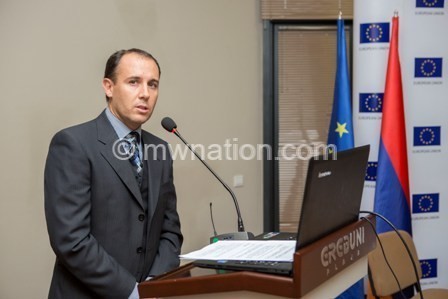‘EU market being underutilised’
Despite having access to duty free and quota free access to the European Union (EU) single market for all products but arms, Malawi is yet to fully utilise the trade opportunity.
EU team leader for economic, trade and governance section Jose Navarro said this on the sidelines of the EU-funded Institute of Chartered Accountants in Malawi (Icam) Student Debate launch on Wednesday in Blantyre.

He said energy and infrastructure challenges continue to dampen the country’s potential from benefitting from the Everything but Arms (EBA) trade regime.
“Malawi has a lot of potential to benefit from the trade regime that we offer. At the moment, Malawi benefits from EBA where they send any exports to the EU quota and tariff free but Malawi could do much much better.
“We are putting programmes in place to achieve better standards, connecting regional infrastructure but more needs to be done. Malawi is at the bottom of the economic table,” Navarro said.
A country is granted EBA status if it is listed as a least developed country (LDC) by the United Nations Committee for Development Policy.
Malawi has historically had the same trading partners as evidenced by Treasury statistics.
In particular in 2016, the Southern Africa Development Community (Sadc) was Malawi’s biggest exporter, having exported products worth $545 million to Malawi.
This was followed by Asia at $525 million, Common Market for Eastern and Southern
Africa (Comesa) at $140 million and the European Union at $134 million.
Malawi’s trade balance has been widening over the years despite various policy interventions to narrow the trade deficit—a negative balance of trade in which a country’s imports exceed its exports
This is despite having policies, strategies and efforts to implement programmes in several key areas in support of trade, industry and the private sector, including the draft private sector strategy, National Investment Policy, National Export Strategy (NES), an updated micro small and medium enterprise (MSME) policy and the Buy Malawi Strategy.
MGDS III sees Malawi narrowing its trade balance in the next five years by 0.5 percentage points to two percent of gross domestic product (GDP) in 2022 from 2.5 percent in 2018.
During the same period, exports of goods and services are expected to increase from 27.2 percent of GDP in 2018 to 28.3 percent of GDP in 2022 while imports of goods and services are expected to decline to 36.9 percent of GDP in 2022 from 41.4 percent in 2018.
Trade experts argue that lack of comparative advantage poses risks for Malawi to lose market share for various trade pacts.
With Malawi being a high cost country on doing business; it reduces competitiveness of local products on the international market, which leaves other economies to take advantage of the situation.
Then Ministry of Industry, Trade and Tourism spokesperson Wiskes Nkombezi admitted that Malawi is still importing more than it exports, with the trade balance in 2022 projected to stand at 9.7 percent of GDP.
Malawi is an agricultural based economy, as such, agricultural products continue to dominate Malawi’s export basket. n





